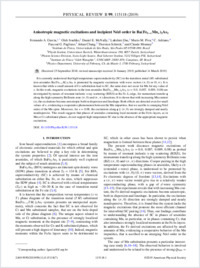Anisotropic magnetic excitations and incipient N\’eel order in $\mathrm{Ba}{({\mathrm{Fe}}_{1\ensuremath{-}x}{\mathrm{Mn}}_{x})}_{2}{\mathrm{As}}_{2}$
- Garcia, Fernando A. Instituto de Física, Universidade de São Paulo, Brazil
- Ivashko, Oleh Physik-Institut, Universitaet Zuerich, Switzerland
- McNally, Daniel E. Photon Science Division, Swiss Light Source, Paul Scherrer Institut, Villigen PSI, Switzerland
- Das, Lakshmi Physik-Institut, Universitaet Zuerich, Switzerland
- Piva, Mario M. Instituto de Física “Gleb Wataghin”, UNICAMP, Campinas, SP, Brazil
- Adriano, C. Instituto de Física “Gleb Wataghin”, UNICAMP, Campinas, SP, Brazil
- Pagliuso, Pascoal G. Instituto de Física “Gleb Wataghin”, UNICAMP, Campinas, SP, Brazil
- Chang, Johan Physik-Institut, Universitaet Zuerich, Switzerland
- Schmitt, Thorsten Photon Science Division, Swiss Light Source, Paul Scherrer Institut, Villigen PSI, Switzerland
- Monney, Claude Physics Department, University of Fribourg, Switzerland
-
14.03.2019
Published in:
- Physical Review B. - 2019, vol. 99, no. 11, p. 115118
English
It is currently understood that high temperature superconductivity (SC) in the transition metal (M) substituted iron arsenides Ba(Fe1−xMx)2As2 is promoted by magnetic excitations with wave vectors (π,0) or (0,π). It is known that while a small amount of Co substitution lead to SC, the same does not occur for Mn for any value of x. In this work, magnetic excitations in the iron arsenides Ba(Fe1−xMnx)2As2(x=0.0,0.007,0.009,0.08) are investigated by means of resonant inelastic x-ray scattering (RIXS) at the Fe L3 edge, for momentum transfer q along the high symmetry Brillouin zone (π,0) and (π,π) directions. It is shown that with increasing Mn content (x), the excitations become anisotropic both in dispersion and lineshape. Both effects are detected even for small values of x, evidencing a cooperative phenomenon between the Mn impurities, that we ascribe to emerging Néel order of the Mn spins. Moreover, for x=0.08, the excitations along q∥(π,0) are strongly damped and nearly nondispersive. This result suggests that phases of arsenides containing local moments at the FeAs layers, as in Mn or Cr substituted phases, do not support high temperature SC due to the absence of the appropriate magnetic excitations.
- Faculty
- Faculté des sciences et de médecine
- Department
- Département de Physique
- Language
-
- English
- Classification
- Physics
- License
-
License undefined
- Identifiers
-
- RERO DOC 324707
- DOI 10.1103/PhysRevB.99.115118
- Persistent URL
- https://folia.unifr.ch/unifr/documents/307822
Statistics
Document views: 121
File downloads:
- pdf: 162
